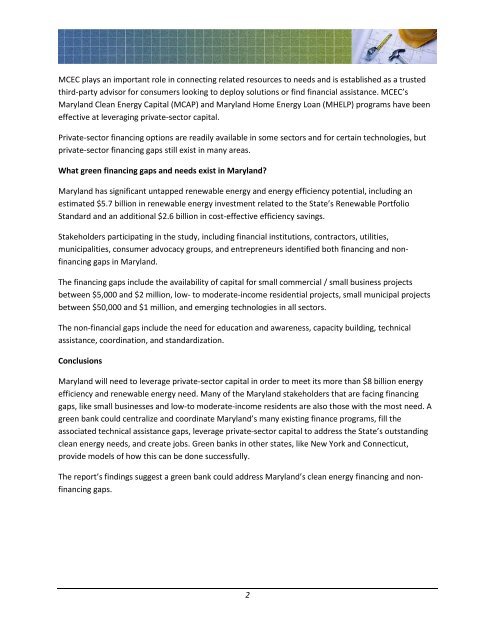bg4kk_f
bg4kk_f
bg4kk_f
You also want an ePaper? Increase the reach of your titles
YUMPU automatically turns print PDFs into web optimized ePapers that Google loves.
MCEC plays an important role in connecting related resources to needs and is established as a trusted<br />
third-party advisor for consumers looking to deploy solutions or find financial assistance. MCEC’s<br />
Maryland Clean Energy Capital (MCAP) and Maryland Home Energy Loan (MHELP) programs have been<br />
effective at leveraging private-sector capital.<br />
Private-sector financing options are readily available in some sectors and for certain technologies, but<br />
private-sector financing gaps still exist in many areas.<br />
What green financing gaps and needs exist in Maryland?<br />
Maryland has significant untapped renewable energy and energy efficiency potential, including an<br />
estimated $5.7 billion in renewable energy investment related to the State’s Renewable Portfolio<br />
Standard and an additional $2.6 billion in cost-effective efficiency savings.<br />
Stakeholders participating in the study, including financial institutions, contractors, utilities,<br />
municipalities, consumer advocacy groups, and entrepreneurs identified both financing and nonfinancing<br />
gaps in Maryland.<br />
The financing gaps include the availability of capital for small commercial / small business projects<br />
between $5,000 and $2 million, low- to moderate-income residential projects, small municipal projects<br />
between $50,000 and $1 million, and emerging technologies in all sectors.<br />
The non-financial gaps include the need for education and awareness, capacity building, technical<br />
assistance, coordination, and standardization.<br />
Conclusions<br />
Maryland will need to leverage private-sector capital in order to meet its more than $8 billion energy<br />
efficiency and renewable energy need. Many of the Maryland stakeholders that are facing financing<br />
gaps, like small businesses and low-to moderate-income residents are also those with the most need. A<br />
green bank could centralize and coordinate Maryland’s many existing finance programs, fill the<br />
associated technical assistance gaps, leverage private-sector capital to address the State’s outstanding<br />
clean energy needs, and create jobs. Green banks in other states, like New York and Connecticut,<br />
provide models of how this can be done successfully.<br />
The report’s findings suggest a green bank could address Maryland’s clean energy financing and nonfinancing<br />
gaps.<br />
2


